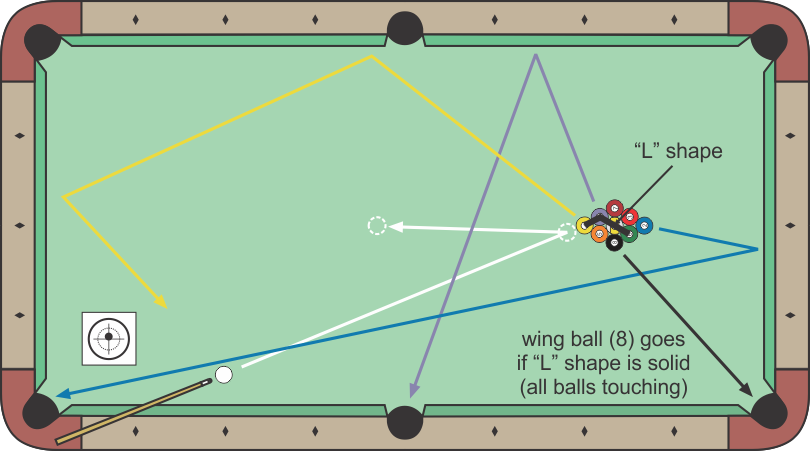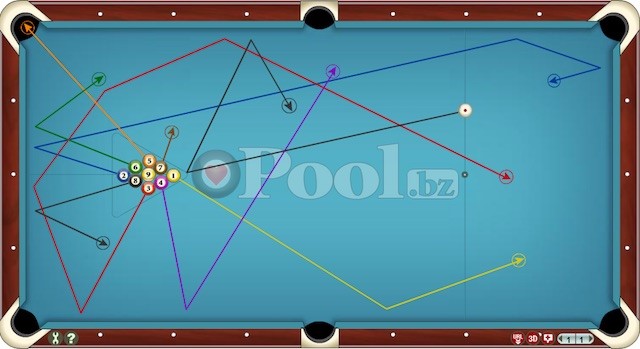What are the best strategies for breaking in 9-ball?
Vol. I of the Video Encyclopedia of Nine-ball and Ten-ball (VENT) covers all 9-ball breaking strategy, effects, and techniques in great detail. This resource is strongly recommended. For a good overview of 9-ball break strategies, for all types of breaking rules, see “9-Ball Break Strategy” (BD, January, 2021), “How to Rack and Break 9-Ball Like a Pro” (BD, March, 2018), and the following videos:
The most important strategy is to have good break technique. This is covered in detail on the break technique resource page and in “How to Break Like a Pro” (BD, September, 2016).
Generally, as shown below, the goal on a 9-ball break (either by breaking from the side rail or with a cut break from the “box”) is to pocket the “wing ball” and squat the CB in the center of the table to get a shot at the 1 after the break. For the “wing ball” to go, the four balls in the “L” or “hockey stick” path must be frozen. If they are not, the wing ball will generally go too high. An easy way to remember which side to break from is the CB should form a boomerang shape with the frozen-ball path. If there is a gap, break from the other side, assuming the opposite boomerang path is frozen.

An alternative way to get a look at the 1 is a softer draw break like this:
If the 9 is racked on the spot, the wing ball can be pocketed by breaking from the side with a cut break, where you hit the 1 at a slight angle (off square slightly) on the outside. You can also pocket the 1 in the side or bank it off the side rail to the upper corner pocket. You can change the directions the wing and 1 balls head by changing the amount of cut (more cut makes both balls go lower). The far corner ball (opposite the wing ball) can also have a tendency to bank three rails to the side pocket with a 9-on-the-spot side cut break (depending on conditions and the amount of cut). Here are demonstrations of various 9-on-the-spot break strategies:
An advantage of a cut break is that the CB can come off the side rail into the stationary 9, possibly resulting in a “golden break” (pocketing the 9 on the break); although, there is a risk of scratching with this approach. For demonstrations along with other approaches to pocket the 9 on the snap, see:
For more info, see: “Golden Break!” (BD, September, 2023). If the 3-point rule is in force, and you are required to break “from the box,” a larger cut is required to pocket the wing ball (especially if the 9 is on the spot), and a cut break can be a little risky since you cannot get as much power into the rack.
If the 9 is racked on the spot, and if you are required to break from the box, and if the 2 is placed in the back of the rack (as it is in some tournaments), a good approach is to pocket the 1 in the side and send the 2 four rails for shape in the side pocket like this:
If pattern racking and ball gapping is not prohibited, you might want to take advantage of those approaches (maybe in combination with a soft break per the Corey Deuel example on the pattern racking page).
The following videos also have some useful advice and analysis of what some top pros do to break well (and sometimes cheat):
For more information, see: “How to Rack and Break 9-Ball Like a Pro” (BD, March, 2018).
It is helpful to know racking and breaking strategy, but it is just as important to know how to get a tight rack.
Here are some statistics for effectiveness of pro 9-ball breaks.
Here are some example great breaks by pros:
And here are some more:
- 7 balls on the break by Hamookis (Saudi player)
- 7 balls on break by Buddy Mael on Facebook (amateur player)
- 6 balls pocketed with a golden break by Hong Son (Vietnamese player)
- 6 balls pocketed by Jeffrey de Luna
- 6 balls on the break by Jose Garcia in APA online match
- 5 balls on the break by Albin Ouschan
- 5 balls on the break by Efren Reyes
from Jeff Johnson (in Facebook post):
In the TAR 17 match vs Shane , Donny Mills repeatedly executed the most amazing 9-ball break I’ve ever seen (see below). Notice how the 1-4 balls end on one side of the table and 6-9 on the other. Notice also that the 3-ball goes two rails and RICOCHETS off the 6-ball, sending the 3-ball up table. I’m not lying; he did it time after time.

Dr. Dave keeps this site commercial free, with no ads. If you appreciate the free resources, please consider making a one-time or monthly donation to show your support:
